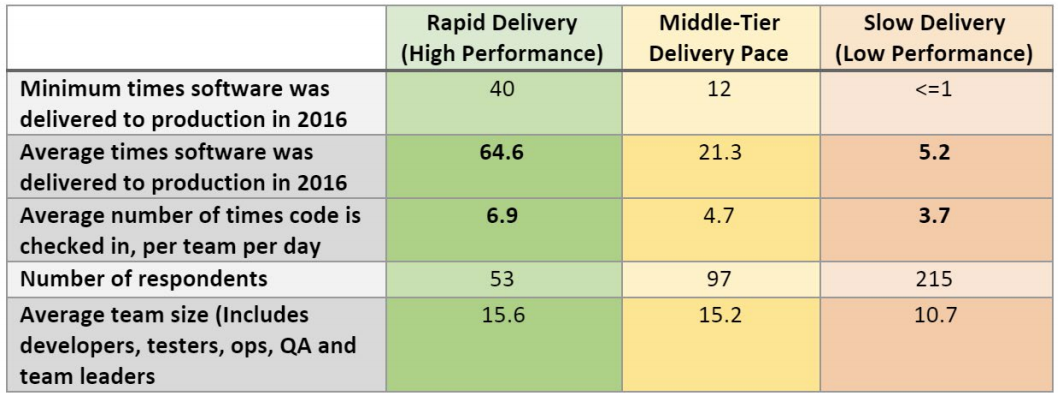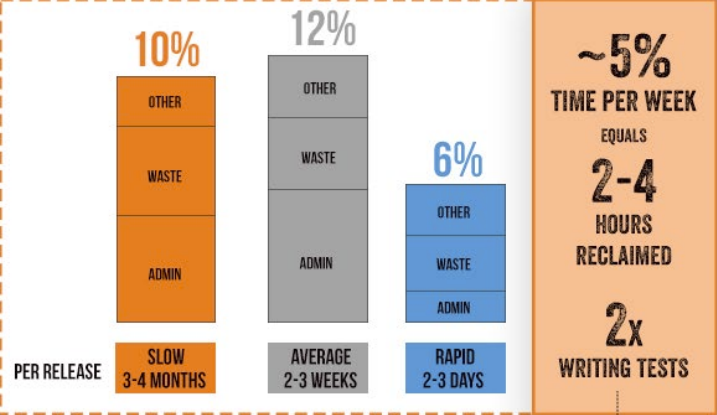In today’s competitive digital landscape, enterprise web and mobile developers are under a great deal of pressure to deliver unique experiences that draw in users and keep them engaged. Needless to say, some have been more successful than others. But what sets DevOps leaders apart from the laggards?
According to a recent study of 478 mobile developers, sponsored by Perfecto Mobile in partnership with Smith’s Point Analytics, developers spend, on average, less than 50% of their time writing code. And that statistic holds true across high-performing, mid-performing, and low-performing teams. Here's how we categorized teams that participated in the study in terms of performance:
The difference in release frequency between fast teams and slow teams is extreme. High-performance teams release software to production two to three times per week. Low performers tend to release in large batches, closer to once per quarter.
At the end of the day, high-performing dev teams do not spend any more or less time coding than do their peers. So how do they do it?
DevOps leaders focus on delivering against changing user requirements and hone in on processes as a key competitive advantage. Here are four key practices that set DevOps leaders apart from the competition.
They release faster, and with quality
High-performance dev teams release software to production two to three times per week, while low performers tend to release in large batches closer to once per quarter. Speed is a key differentiator because it allows for more opportunity to hypothesize, act, and learn how to better satisfy users. Development teams that deliver high-quality code on a frequent, regular basis are able to execute on a more efficient learning loop and more quickly deliver new features and products to users.
While a weekly release cycle may not be achievable for all teams, increasing automation can help developers deliver high-quality code more quickly. What’s more, testing and review cycles must be short; they cannot be left to lengthy, large batches of work. High-performing teams embed these practices into a continuous process, leaning on automation to minimize redundant work.
They define and test user experiences early
High-performance teams tend to embed quality into all stages of the software delivery lifecycle; these developers define and test the user experience early and often. The result is better-performing apps that keep up with quickly changing user needs. High-performance teams are also more than twice as likely to bake nonfunctional criteria into user stories during the early planning phases. And they cover more features with unit and user interface testing, spending twice as much time testing than do lower performers.
They waste less time on overhead tasks
Often, high-velocity software delivery comes down to a game of inches. Just two to four hours per developer per week can translate into higher-quality new features, a reduction of technical debt, and significant process improvement. With that in mind, it should come as no surprise that high-performing teams spend 5% to 10% less time on overhead tasks such as administration and waste and spend 5% more time writing tests than do mid-performing and low-performing teams.
High-performing teams spend 3% of their time on admin and waste, while mid-tier performers spend 7% and low performers 8%.
The lesson here is that you must carefully manage overhead, because inefficiencies can add up quickly, and developers should be focused on activities that contribute to team velocity. High-performing teams reclaim a few hours each week and use that time to test and act on user feedback.
They have early access to UI feedback
High-performing teams are twice as likely to receive early user interface (UI) feedback than are their mid-performing and low-performing counterparts. This allows teams to assess how code changes affect the user experience and enables developers to act on a more reliable release process. More than 50% of UI and UX developers say they want better feedback during the coding and debugging process, but less than 25% actually get the timely feedback they need.
Make it happen for your teams
Ultimately, high-performance teams are able to deliver updates every few days, rather than once a quarter, because they aren’t bogged down by overhead tasks. Instead, they spend their time collecting early user feedback and acting on those learnings. Maintaining this level of speed and quality is only possible if your teams embed fast feedback loops across the development cycle. Doing so will help your teams stay competitive in the growing app market.
Keep learning
Take a deep dive into the state of quality with TechBeacon's Guide. Plus: Download the free World Quality Report 2022-23.
Put performance engineering into practice with these top 10 performance engineering techniques that work.
Find to tools you need with TechBeacon's Buyer's Guide for Selecting Software Test Automation Tools.
Discover best practices for reducing software defects with TechBeacon's Guide.
- Take your testing career to the next level. TechBeacon's Careers Topic Center provides expert advice to prepare you for your next move.





